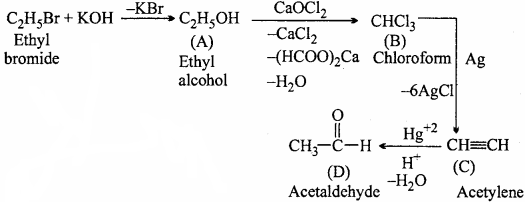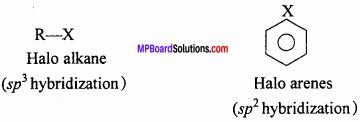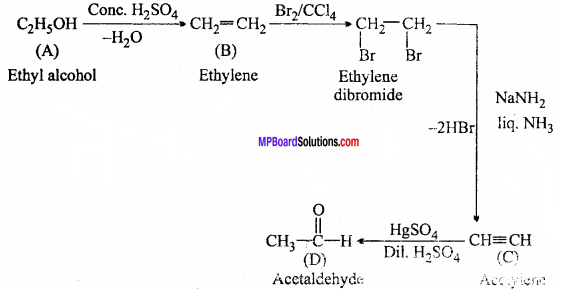MP Board Class 12th Chemistry Important Questions Chapter 10 Haloalkanes and Haloarenes
Haloalkanes and Haloarenes Important Questions
Haloalkanes and Haloarenes Very Short Answer Type Questions
Question 1.
What is plane polarized light?
Answer:
Light which vibrates in one specific plane is known as plane polarized light. On passing normal light through a Nicol prism, plane polarized light is obtained.
Question 2.
Write an example of 3° alkyl chloride.
Answer:
Tertiary butyl chloride

(2-chloro-2-methyl propane)
Question 3.
What is the order of boiling points of alkyl halides for the same alkyl group?
Answer:
Decreasing order of boiling points : RI > RBr > RCl > RF.
![]()
Question 4.
Write the equation of Swart’s reaction.
Answer:
![]()
Question 5.
What are Enantiomers?
Answer:
The stereoisomers related to each other as non – superimposable mirror images are called Enantiomers.
Question 6.
What are polyhalogen compounds? Give two examples.
Answer:
Carbon compounds which contain more than one halogen atom are known as polyhalogen compounds like CHCl3, CCl4 etc.
Haloalkanes and Haloarenes Short Answer Type Questions
Question 1.
- Write Iodoform reaction.
- Iodoform gives yellow ppt. with AgNO3 solution but chloroform doesn’t Why?
- What happens when ethyl bromide is heated with alcoholic KOH?
Answer:
1. Iodoform reaction:
When ethyl alcohol or acetone is heated with iodine and NaOH, yellow crystals of iodoform are formed.
C2H5OH + 4I2 + 6NaOH → 5Naf + HCOONa + 5H2O + CHI3
2. When iodoform is heated with AgNO3 solution a yellow ppt. (Agl) is obtained but chloroform doesn’t give this reaction because in chloroform C – CI bond is more stable than C – I bondin iodoform.
3. On boiling Ethyl bromide with alcoholic KOH ethylene is formed.
![]()
Question 2.
Explain the Sandmeyer reaction with example.
Answer:
Decomposition of diazonium salts (Sandmeyer reaction):
When a diazonium salt solution is added to a solution of cuprous halide dissolved in the corresponding halogen acid, the diazo group is replaced by a halogen atom.

Question 3.
Give chemical reaction between chlorobenzene and chloral in presence of cone. H2SO4.
Or, How is D.D.T. formed? Write its one application.
Answer:
DDT (Dichlorodiphenyl trichloroethane) is formed by the condensation of one molecule of chloral with two molecules of chlorobenzene in presence of cone, H2SO4.

Application : It is an important pesticide.
Question 4.
What are Gem – dihalide and Vicinal – dihalide?
Answer:
When both halogen atoms are linked to one carbon atom of hydrocarbon then it is known as Gem-dihalide. Gem means geminal i. e., same position.

When both halogen atoms are connected to two different neighbouring carbon atoms, then it is known as vicinal dihalide. Vic means vicinal which means adjacent position.

Question 5.
What is Lucas reagent? Give its application.
Answer:
Solution of ZnCl2 in cone. HCl is known as Lucas reagent.
Application:
It is used to differentiate primary, secondary and tertiary alcohols.
On adding the alcohol to Lucas reagent, a tertiary alcohol reacts immediately forming a ppt. of alkyl chloride. If the ppt. appears after few minutes, then the alcohol is secondary. If no ppt. is obtained in cold the alcohol is primary.
![]()
Question 6.
Explain, Carbylamine reaction and give one application of this reaction. (MP 2018)
Answer:
Carbylamine reaction: On heating chloroform with primary amine (e.ganiline) and alcoholic KOH solution, phenylisocyanide or carbylamine is formed which has a very bad smell and is poisonous.

Application : Chloroform and primary amine can be tested by this reaction.
Question 7.
What is 666 (lindane)? Explain its preparation and use in agriculture.
Answer:
It is 1, 2, 3, 4, 5, 6 – HexachIorocyciohexane. It is obtained by heating benzene with chlorine in presence of sunlight.
Preparation : It is prepared by the chlnncriUiv benzene in the presence of ultraviolet light.

1,2, 3,4, 5, 6 – Hexachlorocyclohexane (B.H.C.)
Uses:
Benzene hexachloride is an addition compound and its γ – isomer is called gammexane. It is an important pesticide used in agriculture. It is also called lindane or 666.
Question 8.
Explain the following reaction of chlorobenzene:
- Ration with chlorine in the presence of FeCI3 in dark
- Fittig reaction.
Answer:
1. When Chlorobenzene reacts with Cl2 hi the presence of FeCl3 in dark. o – dichlorobenzene and p – dichlorobenzene is obtained.

2. Fittig reaction : When Chlorobenzene is heated at 200°C with Cu powder in a sealed tube Diphenyl is formed.

When two molecules of aryl halide reacts with sodium metal in presence of dry ether, then diphenyl is formed. This reaction is known as Fittig reaction.

Question 9.
Write short notes on :
- Hunsdiecker method and
- Raschig process.
Answer:
1. Hunsdiecker method : When silver salt of a carboxylic acid is heated with bromine, in the presence of an inert solvent like CCl4, aryl bromide is formed.

This method is called Hunsdiecker method.
2. Raschig process : When benzene vapours mixed with air and HCl gas is passed over CuCl2 (catalyst) at 230°C, chlorobenzene is formed.

Question 10.
Write method of preparation, properties and uses of Freon.
Answer:
Freon : Dichloro, Difluoro methane.
it is formed by the action of SbF3 with CCl3 in presence of SbCl5.
![]()
It has very low boiling point due to which by increasing the pressure at room temperature it can be liquefied. It is a non – poisonous, non – combustible and inactive substance which is used as a cooling agent in the refrigerator. It is used in aerosol and foam.
![]()
Question 11.
- B.P. of ethyl iodide is higher than b.p. of ethyl bromide. Give reason.
- Explain why the m.p. of para dichlorobenzene is higher than its ortho arid meta derivatives.
Answer:
- In alkyl halides containing same alkyl group boiling point increases with increase in atomic weights of halogen atoms. Molecular weight of ethyl iodide is more than ethyl bromide and therefore boiling point of ethyl iodide is also high.
- Para derivatives of dichlorobenzene is more symmetrical than its ortho and meta derivatives therefore its m.p. is higher.
Question 12.
Explain Friedel – Craft’s reaction with chemical equation,
Answer:
Friedel – Craft’s reaction (alkylation) : Alkyl halides react with benzene in presence of anhydrous aluminium chloride to give alkyl benzene.

Acetylation:
Acetyl chloride reacts with benzene in presence of anhydrous aluminium chloride to give acetophenone.

Question 13.
Give the uses of freon – 12, D.D.T., Carbon tetrachloride and Iodoform. (NCERT)
Answer:
It is an important pesticide.
Freon – 12:
Since freons have been found to be one of the factors responsible for the depletion of ozone layer, they are being replaced by other harmless compounds in many countries.
D.D.T:
DDT is highly toxic and has strong insecticidal properties and thus it was widely used as an insecticide and pesticide.
Carbon Tetrachloride:
It is produced in large quantities for use in the manufacture of refrigerants and propellants for aerosol cans. It is used as feed stock in the synthesis of chlorofluorocarbons and other chemicals, pharmaceutical manufacturing and general solvents use. Until the mid 1960’s, it was widely used as a cleaning fluid both in industry as a degreasing agent and in the home, as a spot remover and as fire extinguisher.
Iodoform:
It was earlier used as an antiseptic but the antiseptic properties are due to the liberation of free iodine and not due to iodoform itself. Due to its objectionable smell, it has been replaced by other formulations containing iodine.
Question 14.
Name of the following halides according to IUPAC system and classify them as alkyl, allyl, benzyl (primary, secondary, tertiary), vinyl or aryl halides : (NCERT)
- (CH3)2CHCH(CI)CH3
- CH3CH2CH(CH3)CH(C2H)CI
- CH3CH2C(CH3)2CH2I
- (CH3)3CCH2CH(Br)C6H5
- CH3CH(CH3)CH(Br)CH3
- CH3C(C2H5)2CH2Br
- CH3C(CI)(C2H5)CH2CH3
- CH3CHC(Cl)CH2CH(CH3)2
- CH3CH=CHC(Br)(CH3)2
- p – ClC6H4CH2CH(CH3)2
- m – ClCH2C6H4CH2C(CH3)3
- o – Br – C6H4CH(CH3)CH2CH3.
Answer:
- 2 – Chloro – 3 – methylbutane (2° alkyl)
- 3 – Chloro – 4 – methyIhexane (2° alkyl)
- 1 – Iodo – 2,2 – dimethylbutane (1° alkyl)
- 1 – Bromo – 3,3 – dimethyl – 1 – phenylbutane (2° benzylic)
- 2 – Bromo – 3 – methylbutane (2° alkyl)
- 3 – Bromomethyl – 3 – methylpentane (1° alkyl)
- 3 – Chloro – 3 – methylpentane (3° alkyl)
- 3 – Chloro – 5 – methylhex – 2 – ene (vinyl)
- 4 – Bromo- 4 – methylpent – 2 – ene (allylic)
- 1 – Chloro – 4 – (2′-methylpropyl) benzene (aryl) or p – Chloro isobutyl benzene
- 1 – Chloromethyl-3-(2’2′-diethylpropyl) benzene (benzylic) or m – Neopentyl benzyl chloride
- 1 – Bromo – 2 – (l’ – methylpropyl) benzene (aryl).
Question 15.
Identify ‘A’, ‘B’, ‘C’ and ‘D’.

Answer:

Question 16.
Write the equation of following reactions of chlorobenzene : (MP 2015)
- Halogenation
- Nitration
- Sulphonation
- Alkylation.
Answer:
1. Halogenation : Haloarene reacts with halogen in presence of halogen carrier like FeCl3 to form ortho and para substituted dihaloarene.

2. Nitration : Haloarenes react with nitrating mixture to form o – nitro and p – nitro substituted haloarenes.

3. Sulphonation : On heating with cone. H2SO4, 2 – Chlorobenzene sulphonic acid and 4-Chlorobenzene sulphonic acid are formed.

4. Alkylation : Alkylation takes place with alkyl halide in presence of anhydrous A1C13.

Haloalkanes and Haloarenes Long Answer Type Questions
Question 1.
Explain the nucleophilic substitution reaction in alkyl halide by SN1 and SN2 medianism.
Answer:
Nucleophilic substitution reaction:
In the carbon halogen bond ofhaloalkane. halogen atom is more electronepativ0 as compared to the carbon atom hence, the shared pair of electrons between carbon and halogen is more attracted by the halogen atom. As a result a small negative charge and an equivalent positive charge develops on halogen atom and carbon atom respectively.
Nucleophile attacks the electron deficient carbon due to the presence of partial positive charge on it and replaces the weaker nucleophilic ion i.e. the halide ion. Thus, the reaction is known as nucleophilic substitution reaction.
![]()
The order of reactivity of different alkyl halide towards nucleophilic substitution reaction is:
RI > RBr > RC1 > RF
Mechanism of Nucleophilic substitution reactions :
Nucleophilic substitution reaction occurs through two different mechanism :
(1) SN1 Mechanism (Unimolecular nucleophilic substitution) : In this mechanism following steps are involved :
(a) Formation of carbocation by dissociation of substrate i.e., reactant molecule.
![]()
(b) Attack of nucleophile on carbocation forming the product.
![]()
(2) SN2 mechanism (Bimolecular nucleophilic substitution):
Reactions of this type occur in one step i.e. they are concerted reactions. These reaction nucleophilic attack results in a transition state in which both the reactant molecules are partially bonded to each other and then the halide ion escapes out forming the product.
ROH– + CH3X → CH3OH + RX

Rate of reaction = K[(RX)OH–]
Order of reactivity of alkyl halide is : Primary > Secondaxy > Tertiary.
![]()
Question 2.
Draw labelled diagram of laboratory method for preparation of iodoform from akfohol. Write related chemical equation.
Answer:

Chemical reaction:

Question 3.
Write the structure of the major organic product in each of the following reactions: (NCERT)

Answer:

Question 4.
Give the laboratory method for the preparation of chloroform. Describe the formation of chloroform by ethanol with labelled diagram, equation and principle.
Answer:
Laboratory method : Chloroform is prepared in the laboratory by the action of water and bleaching powder on ethyl alcohol or acetone.
Method:
About 100 gm of bleaching powder made into a paste by adding about 200 ml of water and taken in a flask fitted with a condenser. Now, 25 ml of alcohol or acetone is added and the mixture is distilled, chloroform collects as a heavy liquid under water.
It is washed with dilute NaOH solution then with water, dried over fused calcium chloride and redistilled. The available chlorine of bleaching powder acts as oxidising as well as chlorinating agent during the preparation of chloroform from alcohol and acetone.
CaOCl2 + H2O → Ca(OH)2 + Cl2

The chemistry involved in the conversion of alcohol and acetone into chloroform is as shown below:
(A) From alcohol: The steps involved are :
(i) Ethyl alcohol is oxidized by chlorine to acetaldehyde.
![]()
(ii) Acetaldehyde reacts with chlorine to give chloral, i.e. trichloro acetaldehyde.
![]()
(iii) Two moles of chloral react with one mole of calcium hydroxide to produce chloroform.

Calcium hydroxide Chloral Chloroform Calcium formate.
![]()
Question 5.
MaloaIkanes are more reactive than haloarenes. Give reason.
or,
Why, aryl halides are less reactive than alkyl halides?
Answer:
In aryl halides, halogen atom is attached more strongly to the nucleus therefore the nucleophilic substitution takes slowly than alkyl halides. There is two reasons for the less reactivity of aryl halides.
(i) In aryl halides sp3hybridization takes place whereas in alkyl halides sp2 hybridization is present due to sp2 hybridization in haloarenes the halogen are attached to nucleus more strongly.

(ii) Due to the presence of resonance in aryl halides there is some double bond character in C – Cl bond. Thus, the bond length of C – Cl bond is lesser than C – Cl bond in haloalkanes. Therefore, it is difficult to replace the halogen of haloarenes.

Question 6.
What product is formed by the reduction of chloroform? Give the chemical equation when it reacts to nitric acid and acetone.
Answer:
Reduction:
1. On heating with Zn and HCl, it reduces to form methylene dichloride.

2. On heating with zinc dust and water, methane is formed.

Reactions of Chloroform :
1. With Conc.HNO3:
On treating chloroform with concentrated nitric acid, the hydrogen atom of chloroform is replaced by nitro group and nitro chloroform (or chloropicrin) is formed. It is a liquid (b.p. 112°C) which is used in war as a poisonous gas.

2. With Acetone:
Chloroform condenses with acetone in presence of sodium hydroxide to form chloretone which is a hypnotic (sleep inducing drug) of high grade.

Question 7.
Give the Chemical reaction when chloroform reacts with following:
- Oxidation
- Carbylamine reaction
- Ag powder
- Nitration
- Reimer – Tiemann reaction.
Or
How will you obtain the following from chloroform:
- Carbonyl chloride
- Acetylene
- Chloropicrin
- Phenyl isocyanide
- Chloretone
- Salicylaldehyde.
How trichloro methane reacts with :
- Atmospheric air
- Aniline and ale. KOH
- Ag powder
- Cone. HNO3
- Phenol
- Acetone.
Answer:
(a) Action of air and light (Oxidation):
Chloroform oxidizes in presence of sunlight and air and forms a poisonous gas, phosgene (carbonyl chloride).

Ordinary chloroform contains phosgene gas and is used as a solvent. Pure chloroform which is used as an anaesthetic does not contain even traces of phosgene. While preserving chloroform which is to be used as an anaesthetic, the following precautions are taken:
(i) The chloroform is filled in blue or brown coloured bottle up to the neck. After putting a stopper, the bottle is kept in dark. As there is no empty space in the bottle, it is also to from air
(ii) One percent ethyl alcohol is added in the bottle. If phosgene gas is formed, alcohol reacts with it to form diethyl carbonate, a non – toxic substance, i.e. (C2H5)2CO3

(b) Carbylamine reaction:
On heating chloroform with primary amine (example aniline) and alcoholic KOH solution, phenylisocyanide or carbylamine is formed which has a very bad smell and is poisonous.
![]()
(c) Reaction with Ag powder or Dehalogenation: On heating chloroform with silver powder, pure acetylene gas is formed.
CHC13 + 6Ag + CI3CH → HC ≡ CH + 6 AgCl
(d) Nitration:
Haloarenes react with nitrating mixture to form o – nitro and p – nitro substituted haloarenes.

(e) Reimer – Tiemann reaction:
On heating chloroform with concentrated alkali and phenol at 60 – 70°C, o – hydroxy benzaldehyde (salicylaldehyde) is formed. Traces of p- hydroxybenzaldehyde are also formed.

(f) Acetone :
Chloroform condenses with acetone in presence of NaOH to form chloretone which is a hypnotic of high grade.

Question 8.
An alcohol ‘A’ on reaction with cone. H2SO4 gives an alkene ‘B’. ’B’ after bromination with sodamide gives dehydrogenated compound ‘C’. ‘C’ on reaction of H2SO4 in presence of H2SO4 gives ‘D’. Identify ‘A’, ‘B% ‘C’, and ‘D’. (MP 2017)
Answer:
